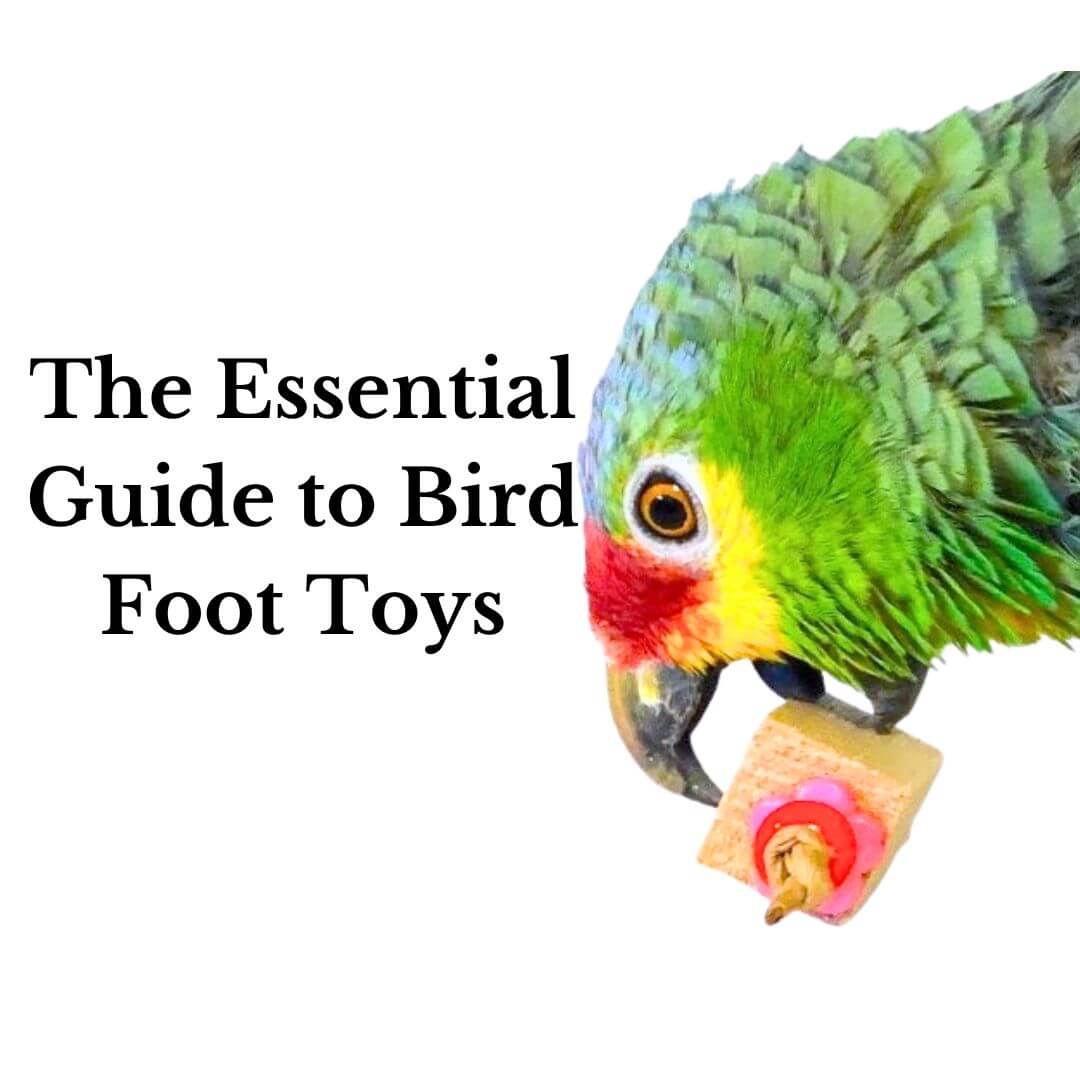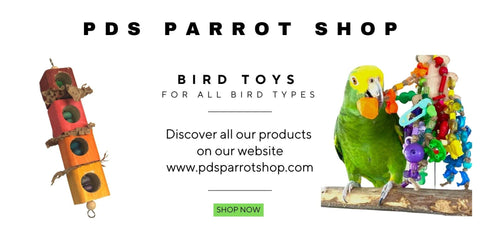
The Essential Guide to Bird Foot Toys
Birds, especially parrots, are incredibly intelligent, active creatures that need more than just food, water, and shelter to thrive. Parrots, with their unique personalities and boundless energy, require stimulation to keep them engaged and happy. This is where bird foot toys come into play. These simple but effective toys do wonders for a parrot's physical and mental well-being, often bringing out their natural foraging, gripping, and problem-solving skills.

What Exactly Are Bird Foot Toys?
At their core, bird foot toys are toys specifically designed for a parrot’s feet. Unlike toys that parrots chew or climb on, foot toys are crafted to be grasped, squeezed, and manipulated using a bird’s dexterous feet. Parrots have zygodactyl feet, meaning they have two toes pointing forward and two pointing backward, which allows for an impressive grip and makes them naturally skilled at holding and maneuvering objects. Foot toys play to this ability, encouraging parrots to use and strengthen their feet while giving them a safe way to engage in their natural behaviors.
Why Bird Foot Toys Matter: Key Benefits for Parrots
Foot toys aren't just for fun—they play an important role in supporting a parrot's physical and mental health. Here are the main benefits of incorporating foot toys into your parrot’s daily life:
1. Physical Exercise
Parrots are naturally active, but many pet birds don’t get as much movement as their wild counterparts. Engaging with foot toys exercises the foot muscles, which is important for balance and overall mobility. For larger birds, like macaws or African greys, these toys can be essential for maintaining foot strength, which is crucial for gripping perches and climbing.
2. Mental Stimulation
Parrots are highly intelligent and need daily mental engagement to avoid boredom. Manipulating foot toys requires problem-solving skills and patience, which keep a bird’s mind sharp. Toys with different textures, colors, or sounds provide varied sensory feedback, enriching the parrot's experience and helping to keep their brain active. This kind of mental exercise is key to preventing behavioral issues, like feather plucking or excessive screaming, that often arise from boredom or lack of stimulation.
3. Supporting Natural Behaviors
In the wild, parrots use their feet not only for climbing but also for exploring their surroundings, picking up objects, and even searching for food. Foot toys tap into these instinctual behaviors, offering an outlet for natural actions in a safe, controlled environment. This can be especially beneficial for parrots that may have limited opportunities to explore due to space constraints or other environmental limitations.
4. Developing Dexterity and Strength
Much like humans who practice exercises to keep their hands and fingers agile, parrots also need to maintain their foot dexterity. Foot toys encourage repetitive gripping and moving motions that help birds build and sustain strength in their feet. For parrots recovering from injuries, specific foot toys can be a gentle way to rehabilitate and regain mobility, helping them return to full strength over time.
5. Reducing Stress and Anxiety
Parrots are prone to stress if they’re bored or feel neglected, which can lead to destructive behaviors. Interactive foot toys provide a form of stress relief, as they require concentration and focus, distracting the bird from any feelings of anxiety. Additionally, these toys create a positive mental outlet, helping birds feel calmer and more content, which contributes to a balanced emotional state.
Choosing the Right Bird Foot Toys for Your Parrot
Selecting the best bird foot toys for your bird can make a world of difference in how much they enjoy and benefit from their toys. Here are some guidelines to consider when choosing foot toys:
Size and Safety
The size of the toy is crucial to ensure that it’s comfortable and safe for your bird to play with. Smaller birds, like budgies or cockatiels, need smaller toys that won’t overwhelm their grip, while larger parrots require toys sturdy enough to withstand their powerful grip and beaks. Additionally, safety is paramount. Avoid toys with small, detachable parts that could be swallowed or cause injury.
Material Matters
Foot toys are available in a variety of materials. Natural materials like wood, coconut shell, or untreated leather are great choices for foot toys, as they offer a safe and sturdy option for birds to grip, chew, or swing around. Durable plastics can also be suitable, especially for birds with strong beaks, as long as they’re bird-safe and non-toxic.
Variety and Rotation
Birds, especially parrots, can lose interest in toys they see every day. To keep them engaged, offer a variety of foot toys that have different colors, shapes, and textures. Rotating toys regularly not only renews your bird’s interest. A few bird foot toys swapped out every week can keep things exciting and ensure your parrot always has something new to explore.
How to Introduce Bird Foot Toys
Some parrots may be hesitant to try new toys, especially if they’re not used to playing with foot toys. A gradual introduction can help:
-
Start Slowly: Begin by placing a new toy within sight but out of reach. This gives your parrot a chance to observe it without feeling threatened.
-
Use Familiar Objects: If your bird has a favorite type of toy, look for similar foot toys. Parrots often respond well to familiar textures and shapes.
-
Add a Treat: Incorporate a favorite treat into the toy as an extra incentive. Many foot toys are designed to hold small treats, making them more appealing and encouraging interaction.
-
Show by Example: Demonstrate the toy's movement by shaking it or rolling it in front of your parrot. Birds are curious creatures and may be more willing to engage after seeing the toy in action.
Maintaining Bird Foot Toys
Like all toys, foot toys require regular inspection and cleaning to ensure they remain safe and enjoyable for your bird. Check for any signs of wear or damage, especially if your bird has been particularly active with a specific toy. Clean toys frequently, using bird-safe disinfectants or mild soap and water, and rinse thoroughly. Avoid using harsh chemicals, as they may be toxic or leave residues that could be harmful to your bird.
The Role of Bird Foot Toys in Enrichment
Foot toys are just one component of a well-rounded enrichment plan for your parrot. Enrichment means providing a variety of stimulating and engaging activities that encourage your bird to use its natural abilities and instincts. Pairing bird foot toys play with foraging opportunities and or interactive play with owner. The combination of these different types of enrichment are particularly valuable because they engage both the physical and mental aspects of enrichment, offering a balanced approach that supports overall health and happiness.
Conclusion
Bird foot toys may seem simple, but they hold incredible value in a parrot’s life. They provide exercise, mental engagement, and opportunities for natural behaviors—all of which contribute to the well-being of your bird. By choosing the right foot toys, introducing them thoughtfully, and maintaining them well, you can create a more enriching and dynamic environment for your parrot. Foot toys are just one way to show love and care, ensuring that your parrot lives a life filled with joy, stimulation, and the chance to express their natural instincts.
More Articles on Bird Toys
Cockatoo Bird Toys: Ultimate Cockatoo Toy Guide for Happy Birds.
Leather Bird Toys
How to Identify Unsafe Bird Toys | Bird Toy Safety Guide
Author: Monika Sangar
Co-founder of Prego Dalliance Sanctuary, Artisan of PDS Parrot Shop
Monika Sangar is a parrot rescuer, bird food chef, and toy designer with over a decade of experience in avian care and nutrition. She is the founder of Prego Dalliance Sanctuary and the author of The Science of Avian Nutrition, a cookbook dedicated to fresh, healthy meals for parrots. Explore more bird care tips and bird toys at PDS Parrot Shop!






